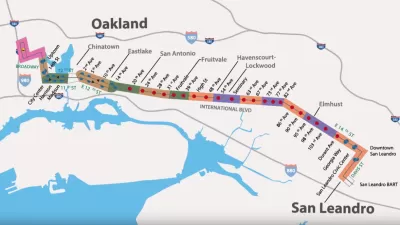Don't confuse East Bay Rapid Transit with Bay Area Rapid Transit: one's a bus, the other heavy rail. But calling it a bus does not do justice to what will be the Bay Area's first bus rapid transit (BRT) line composed primarily of dedicated lanes.
The federal funds will help build the "9.5-mile line, primarily on International Boulevard, connecting downtown Oakland and the San Leandro BART station," writes Wendy Lee of the San Francisco Chronicle. "The transit agency aims to open the line in 2017."
According to the FTA, about 78 percent of the route will have dedicated bus lanes, "as well as 34 new bus stations with real-time arrival information, level boarding platforms and ticket vending machines."
FTA's news release indicates that the $81million comes from three programs:
- $50 million from FTA’s Capital Investment Grant Program,
- $25 million in FTA Bus and Bus Facilities funds, and
- $6 million in Congestion Mitigation and Air Quality Improvement Program funds.
Total cost is $174 million, with state and local funding to provide the remainder.
Lee writes that "AC Transit began mapping out the route for the project in 2001 and at first planned to have line go from San Leandro to Berkeley. However, the project had to be scaled down after there was pushback from Berkeley residents and business owners because it would take away parking. Berkeley dropped out of the plan three years ago."
In an earlier article, the Chronicle's transportation reporter, Michael Cabanatuan, elaborates on the difficulty that San Francisco, the East Bay and the South Bay have encountered in building BRT.
(I)n the Bay Area, the introduction of bus rapid transit is advancing at a pace akin to that of a Muni bus stuck in rush-hour traffic. More than a dozen years after the region started talking about the speedy buses, the Bay Area is still waiting for its first one.
Cabanatuan notes that the first Bay Area BRT line will be in the South Bay, opening in 2015. However, only about 2 miles of the Valley Transportation Authority's 7.2-mile line will have dedicated lanes, according to Transform's senior community planner, Chris Lepe, an advocate for the South Bay's bus rapid transit projects.
FULL STORY: East Bay Rapid Transit Project receives $81 million

Maui's Vacation Rental Debate Turns Ugly
Verbal attacks, misinformation campaigns and fistfights plague a high-stakes debate to convert thousands of vacation rentals into long-term housing.

Planetizen Federal Action Tracker
A weekly monitor of how Trump’s orders and actions are impacting planners and planning in America.

In Urban Planning, AI Prompting Could be the New Design Thinking
Creativity has long been key to great urban design. What if we see AI as our new creative partner?

King County Supportive Housing Program Offers Hope for Unhoused Residents
The county is taking a ‘Housing First’ approach that prioritizes getting people into housing, then offering wraparound supportive services.

Researchers Use AI to Get Clearer Picture of US Housing
Analysts are using artificial intelligence to supercharge their research by allowing them to comb through data faster. Though these AI tools can be error prone, they save time and housing researchers are optimistic about the future.

Making Shared Micromobility More Inclusive
Cities and shared mobility system operators can do more to include people with disabilities in planning and operations, per a new report.
Urban Design for Planners 1: Software Tools
This six-course series explores essential urban design concepts using open source software and equips planners with the tools they need to participate fully in the urban design process.
Planning for Universal Design
Learn the tools for implementing Universal Design in planning regulations.
planning NEXT
Appalachian Highlands Housing Partners
Mpact (founded as Rail~Volution)
City of Camden Redevelopment Agency
City of Astoria
City of Portland
City of Laramie



























